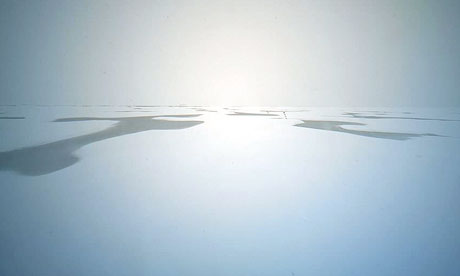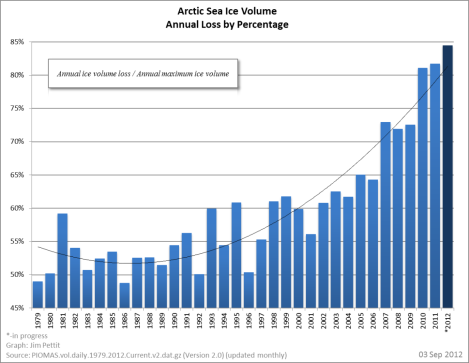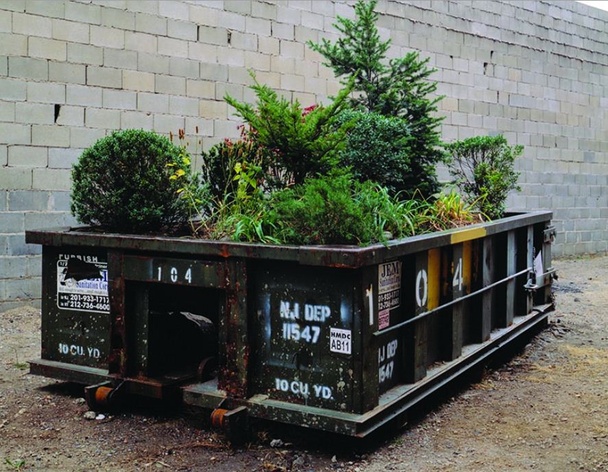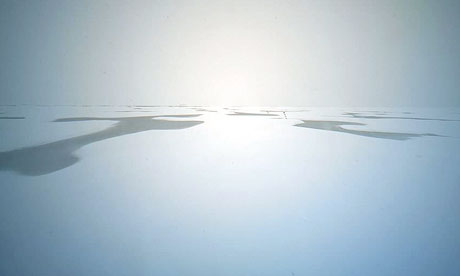
The North Pole, surrounded by pools of water. (Image courtesy of NOAA.)
Cambridge professor Peter Wadhams has a prediction.
Wadhams has spent many years collecting ice thickness data from submarines passing below the arctic ocean. He predicted the imminent break-up of sea ice in summer months in 2007, when the previous lowest extent of 4.17 million square kilometres was set. This year, it has unexpectedly plunged a further 500,000 sq km to less than 3.5m sq km. “I have been predicting [the collapse of sea ice in summer months] for many years. The main cause is simply global warming: as the climate has warmed there has been less ice growth during the winter and more ice melt during the summer.
“At first this didn’t [get] noticed; the summer ice limits slowly shrank back, at a rate which suggested that the ice would last another 50 years or so. But in the end the summer melt overtook the winter growth such that the entire ice sheet melts or breaks up during the summer months.
“This collapse, I predicted would occur in 2015-16 at which time the summer Arctic (August to September) would become ice-free. The final collapse towards that state is now happening and will probably be complete by those dates”.
Wadhams knows more than I do, so I’ll give him the benefit of the doubt on this. Normally, I’d think that this year’s record melt is a blip on a longer, slower trend. Here’s what the ice loss looks like over time:

Percentage of ice loss, by year. Click to embiggen. (Image by Jim Pettit.)
It’s possible that the black line, indicating the overall trend, could reach 100 percent by 2015, to be sure. 2012 could be an anomaly, or it could be the cliff’s edge.
But here’s what’s weird about Wadhams’ prediction.
In an email to the Guardian he says: “Climate change is no longer something we can aim to do something about in a few decades’ time, and that we must not only urgently reduce CO2 emissions but must urgently examine other ways of slowing global warming, such as the various geoengineering ideas that have been put forward.”
These include reflecting the sun’s rays back into space, making clouds whiter and seeding the ocean with minerals to absorb more CO2.
Not sure which of these mandates is less realistic: the urgent reduction of CO2 (requiring political action in the U.S. and economic action in China that won’t happen) or unprecedented geoengineering. Probably the CO2 reduction, sadly.
Then there’s this:
Wadhams says the implications are “terrible”. “The positives are increased possibility of Arctic transport, increased access to Arctic offshore oil and gas resources. The main negative is an acceleration of global warming.”
Every cloud has a silver lining, Professor Wadhams reminds us! Yes, yes, the acceleration of the warming of the Earth will have unpredictable consequences for humans on every continent, nearly all of them negative — but more oil!
With all due respect? Next time maybe skip the “positives” section of your report. Focus more on the “the Arctic is melting and could be entirely gone within a few years and the repercussions of this are massive and unavoidable” part. As we see the ExxonMobil tankers steaming north, their captains clinking champagne glasses on a polar-bear-skin rug, we’ll figure out the “positives” for ourselves.




